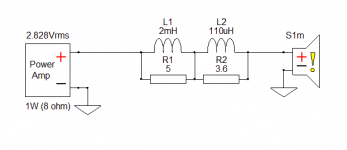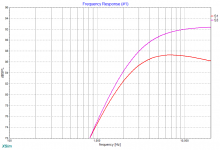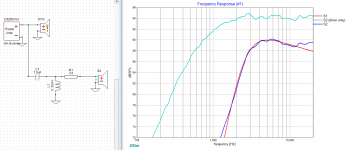My first question would be is there a method to put a house curve in my tweeters passive crossover. Something that attenuates in db/octave.
My next question is if I even could do the above would I be better off just using a MiniDSP to EQ a house curve?
Regards,
Dan
My next question is if I even could do the above would I be better off just using a MiniDSP to EQ a house curve?
Regards,
Dan

I just started asking: what's a house curve?
The one, the FR graph with the slow downward line ?
The one accepted as being the best in a room?
Yes it is.
The one, the FR graph with the slow downward line ?
The one accepted as being the best in a room?
Yes it is.
Usually I use a resistor in series with the tweeter to make it more-less loud.
That's the only thing that comes to my mind.
There are some considerations about the resistor: where, before or after the crossover? before and after, either ?
So what's the tweeter, what's the crossover and how are the speakers placed in the room?
That's the only thing that comes to my mind.
There are some considerations about the resistor: where, before or after the crossover? before and after, either ?
So what's the tweeter, what's the crossover and how are the speakers placed in the room?
Since it's readily possible to overlay a target response to try to copy in a simulator, it is often done this way. EQ is acceptable too, but IMHO EQ is easiest when you don't try to combine EQing for too many different reasons into one so both ways at the same time also makes sense.
As Allen says, use a crossover simulator and import your target curve and tweak away on the simulation.
For a gentle down sloping response like the B&K house curve, you want a low pass filter with a resistor bypass. The low pass filter gives you the downward slope, the resistor bypass controls how much it drops. Usually you don't want to be anywhere near 6dB/octave like a 1st order low pass.
You will normally end up with an inductor in series with the speaker. That inductor will be bypassed by a resistor connected in parallel with the inductor. That's the simplest version, and the place to start.
For a gentle down sloping response like the B&K house curve, you want a low pass filter with a resistor bypass. The low pass filter gives you the downward slope, the resistor bypass controls how much it drops. Usually you don't want to be anywhere near 6dB/octave like a 1st order low pass.
You will normally end up with an inductor in series with the speaker. That inductor will be bypassed by a resistor connected in parallel with the inductor. That's the simplest version, and the place to start.
The problem with just an inductor and a resistor is that you will be making a shelf filter. It will drop, then go flat. That might work on your tweeter, but maybe not so well for an overall filter.
To get closer to a curve like the B&K you'd need two sets of inductors/resistors. Here is an example that would be close to the B&K curve on a perfect speaker with perfectly flat response and a flat impedance. That speaker doesn't exist, but it makes the concept easy to understand.
In practical terms, you might want to apply the curve only to the tweeter, or maybe the mid and tweeter. And they will have complex responses and impedance. That's where using a crossover simulator and save a lot of time.
There are other ways to do this, some just by altering the crossover you already have. No doubt there will be other good ideas pop up in this thread. This is just a simple example to show that it can be done.
To get closer to a curve like the B&K you'd need two sets of inductors/resistors. Here is an example that would be close to the B&K curve on a perfect speaker with perfectly flat response and a flat impedance. That speaker doesn't exist, but it makes the concept easy to understand.
In practical terms, you might want to apply the curve only to the tweeter, or maybe the mid and tweeter. And they will have complex responses and impedance. That's where using a crossover simulator and save a lot of time.
There are other ways to do this, some just by altering the crossover you already have. No doubt there will be other good ideas pop up in this thread. This is just a simple example to show that it can be done.
Attachments
Clever!  That's what I find so fun about passive crossovers on speakers, they are so many ways to achieve a goal. Looking at other people's work is often enlightening.
That's what I find so fun about passive crossovers on speakers, they are so many ways to achieve a goal. Looking at other people's work is often enlightening.
 That's what I find so fun about passive crossovers on speakers, they are so many ways to achieve a goal. Looking at other people's work is often enlightening.
That's what I find so fun about passive crossovers on speakers, they are so many ways to achieve a goal. Looking at other people's work is often enlightening.- Home
- Loudspeakers
- Multi-Way
- House Curve in Passive





